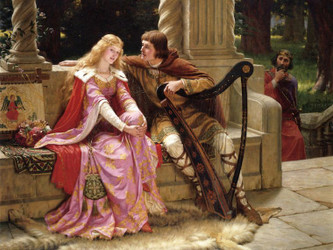Folklore Friday: The Six Greatest Love Stories of Irish Myth
Posted by Olivia O'Mahony on 21st Jan 2022
For many of us, Valentine’s Day is a yearly treat, awarding us opportunities at every turn to spread a little love around. Such as wives and mothers of legendary Irish fishermen who knit thick and robust Aran wool sweaters for their husbands and sons to keep them warm and express their love in this touching and practical way - in an unfavorable and harsh climate. For others, this so-called Hallmark holiday is little more than an annual thorn in the side! Mention V-Day around any group of people, and they reactions you’re bound to get will span everything from delight to dismissal. No matter which side of this argument you fall on, we’re sure you’ll have a lot of fun reading about the six greatest love stories of Irish — the perfect way to honor everything to do with this heavily contentious day.
Note: in keeping with many other traditions of Irish myth, not a single one of these love stories end with a “happily ever after.” Love it or hate it, you’ve been warned! To keep yourself warm and cozy on our long journey into the Irish romantic ‘fairy tales’ don’t forget to grab something soft and comfortable- you can check out our large selection of traditional knit Aran sweaters for ladies and men’s Aran sweaters. Now, let’s get this show on the road…
CLÍODHNA & CIABHAN
In the Mythological Cycle of Irish legend, Clíodhna is a member of the Tuatha Dé Danann, the ancient race of supernatural god-like beings who populated all corners of Ireland before the mortals arrived. Specifically, she was the queen of the banshees, and a figure strongly associated with love and beauty. Clíodhna had her home on the island of Tir Tairngire, the “Land of Promise,” where she kept three birds who ate the fruit of a magical tree. When properly fed, her birds could sing songs so sweet that they could cure any ailment imaginable.
One day, Clíodhna met Ciabhan, a human who lived across the sea in Ireland. The pair were instantly smitten, and despite Clíodhna’s seemingly-perfect and ageless life in Tir Tairngire, she resolved to leave in order to live a mortal life with her beloved. As she journeyed to be by his side, she stopped to rest one night in the harbor of Glandore, Co. Cork. It was there that the other old Irish deities made their feelings on her transgression known: the sea god, Manannán Mac Lir, had one of his minstrels play beautiful music, which lured Cliona to sleep. Defenseless, she was swept away by a powerful wave and drowned, never to reach Ciabhan’s side.
To this day, the strongest tide of Glandore harbor is referred to as Tonn Chlíodhna, or “Cliona’s Wave,” as a way of remembering the powerful force of nature that tore these lovers apart.
FIONN & SADHBH
In the Fenian Cycle of Irish mythology, Fionn mac Cumhaill was the leader of the Fianna, a renowned band of warriors and poets who roamed the land while undertaking heroic quests. One day, while he was out hunting, he encountered a most beautiful doe grazing in the woods. Fionn’s faithful hunting hounds, Bran and Sceólang, who had been born of a woman transformed into a dog, immediately recognized this creature for what it was: a human lady, transformed by the black magic of a druid who she had refused to marry.
Moved, Fionn caught the doe and brought it to his home. As soon as they crossed the threshold of his land, the druid’s curse broke. The young woman introduced herself as Sadhbh, and explained that because of Fionn’s compassion, she could keep her human form as long as she remained on his property. The pair married, and shortly after, Sadhbh became pregnant. All was well until one day, when Fionn was away fighting with the Fianna. The druid who had cursed Sadhbh (he went by the name of Fear Doirich, or the “Dark Man”) made his return, transforming her once more into a deer. When Fionn returned from battle, his wife was nowhere to be found.
Heartbroken, Fionn spent years in search of his missing love, no sign could ever be found of the doe he had stumbled across that day. However, while hunting again one day, he and his hounds discovered a lone newborn fawn, sleeping peacefully in a meadow. Fionn instantly knew that this was he and Sadhbh’s child; he brought the fawn home, where it transformed into a baby boy. Appropriately, Fionn gave him the name Oisín, which translates directly to “little deer.”
DIARMUID & GRÁINNE
After the loss of Sadbh, Fionn married again, this time to a woman named Maigneis. However, as the pair began to age, Maigneis was the first to pass away. Fionn’s men insisted that he marry again, and discovered that Gráinne, daughter of the High King of Ireland, was the worthiest woman in the land to be made his bride. Arrangements for the wedding were set in place. However, when Gráinne and Fionn finally met, she was unnerved to find that he was older than her father. Dismissing him, she instead became infatuated with Diarmuid, one of Fionn’s best and most handsome warriors, who returned her feelings.
During the pre-wedding feast, Gráinne slipped a sleeping potion to everyone but herself and Diarmuid. She begged him to run away with her, and he agreed. They escaped across the River Shannon, with Fionn in hot pursuit, and remained on the run for the duration of many adventures: one involved Gráinne falling pregnant and developing a craving for rowan berries. In order to get them for her, Diarmuid had to fight a giant, and eventually came out of the scrap triumphant.
After many years of the lovers running from place to place, Diarmuid’s father negotiated a truce with Fionn, and they were able to settle in Co. Sligo. One day, Fionn organized a boar hunt, and invites Diarmuid along. In dealing one of the animals a fatal blow, Diarmuid was gored by its tusks and wounded terribly. Fionn, who had the magical gift to cure any ailment by allowing the wounded to drink water from his cupped hands, allowed it to slip through his fingers twice; Diarmuid died, and soon after, so too did Gráinne, her heart broken beyond repair.
OISÍN & NIAMH
In the story of Oisín, a human hero, and Niamh, a princess of Tír na nÓg, or the Land of the Young, our titular pair meet when Niamh is visiting Ireland. Smitten, she brings him back to her homeland, where they marry and begin a new life together. After three years have passed, however, Oisín begs for Niamh’s permission return to Ireland just once, to visit his father. Niamh agrees on one condition: that Oisín rides back to Ireland on her magical horse, and never, ever lets his feet touch the ground. She tells him that if he does not heed her warning, he will never return to Tír na nÓg. He agrees.
Oisín returns to Ireland, but what he finds there brings him only shock and dismay. He discovers too late that three years spent in Tír na nÓg is equivalent to 300 years in Ireland, and that his father has been dead for centuries. Driven to distraction by his grief, Oisín roams all of Ireland on horseback. However, over the course his his travels, he falls to the ground; and, from the moment his skin touches Irish soil, he begins to age. Blind and lame, Oisín dies of natural causes, never to see his immortal love again.
In another version of this story, Niamh’s father, the King, is mad with power and has a druid curse her with the head of a pig, so that no man will ever marry her and he can remain on the throne forever. Luckily, Oisín is compassionate enough to see through the dark magic, and falls in love with Niamh anyway. When they marry, the curse is broken, and together they return to Tír na nÓg to take their rightful place as rulers.
DEIRDRE & NAOISE
The story of Deirdre and Naoise is one of the most commonly-told from the tales of pre-Christian Ireland. Their extent of their tragedy even earned Deidre a nickname by which she is often referred to today: “Deirdre of the Sorrows.”
Upon her birth, it was prophesied that Deidre would grow up to be a young woman of extraordinary beauty, and upon hearing this, King Conchobar mac Nessa swore that when she was to become his bride when she reached a suitable age. However, once blossomed into a lovely young woman, Deidre fell in love with Naoise, a handsome young warrior of Conchobar’s court. Together, they fled to Scotland, and for a time lived happily; however, before long, they were tracked down by the humiliated and furious king. The two went into hiding, taking up lodging at the Red Branch house in Co. Armagh, but were found again. This time, Naoise was killed.
After the death of her beloved, Deirdre was captured and forced to marry Conchobar, though the spite she felt towards him only grew over time. Frustrated with his unhappy marriage, the king planned to give Deirdre away to the man whose spear had slain Naoise. This was too much for the young woman to bear. Upon hearing of Conchobar’s plan for her, Deidre jumped from the chariot in which they rode, finally joining her true love in the embrace of oblivion.
TRISTAN & ISEULT
Our final Valentine’s tale of star-crossed lovers differs from the rest in that its characters aren’t exclusively Irish. This 12th century tragedy concerns romance between Iseult, an Irish princess, and Tristan, a Cornish knight. The story of their love had such an impact on Western art and literature that it’s even sometimes said to have inspired the tale of Sir Lancelot and Queen Guinevere from Arthurian legend, as secrecy and betrayal are critical factors in both narratives.
The story begins when Tristian is sent across the sea by his uncle, the King of Cornwall, bring him Irish princess of famed beauty as a bride. Tristian succeeds — though as the two begin to travel back to his homeland, they accidentally ingest a love potion, causing them to fall for each other. Iseult marries the Cornish King, as planned; however, every time she and Tristian lay eyes on one another, their passion only grows stronger. The King’s advisors soon taken notice, and the two are tried for adultery. Tristian is sentenced to hanging, and Iseult burning at the stake. However, Tristian escapes his fate at the last moment and rescues Iseult. They hide away in the forest for some time, but are discovered by the King. Trapped, Tristian is forced to agree to return Iseult to the King and leave Cornwall forever. Later, he finds himself in Brittany, and there marries a woman also named Iseult, known far and wide for the loveliness of her white hands — a powerful blow to his first love if she ever found out, we’re sure!
Initially published on January 24, 2020

